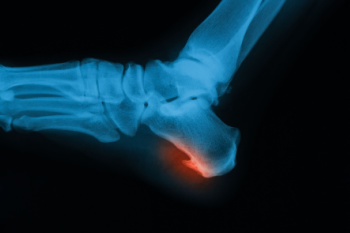
Cuboid syndrome is a condition where the cuboid bone in the foot becomes partially dislocated, leading to pain and discomfort, typically on the outer side of the foot. It often occurs due to an injury, such as an ankle sprain, or from repetitive strain, especially in activities like running or jumping where the foot is under constant stress. Symptoms include sharp pain on the outer side of the foot, difficulty bearing weight, and sometimes swelling. The pain may worsen during activities that involve pushing off with the foot, such as walking, running, or jumping. Early diagnosis and treatment is vital. Treatment typically involves rest and immobilization to reduce inflammation, followed by targeted exercises to restore normal function. A podiatrist might also perform a cuboid manipulation to reposition the bone. Proper footwear, orthotics, and stretching exercises can help to prevent recurrence and support long-term foot health. If you have pain on the outside of your foot, it is suggested that you schedule an appointment with a podiatrist for a proper diagnosis and treatment.
Cuboid syndrome, also known as cuboid subluxation, occurs when the joints and ligaments near the cuboid bone in the foot become torn. If you have cuboid syndrome, consult with Warren Levy, DPM from Armitage Podiatry Center. Our doctor will assess your condition and provide you with quality foot and ankle treatment.
Cuboid syndrome is a common cause of lateral foot pain, which is pain on the outside of the foot. The condition may happen suddenly due to an ankle sprain, or it may develop slowly overtime from repetitive tension through the bone and surrounding structures.
Causes
The most common causes of cuboid syndrome include:
- Injury – The most common cause of this ailment is an ankle sprain.
- Repetitive Strain – Tension placed through the peroneus longus muscle from repetitive activities such as jumping and running may cause excessive traction on the bone causing it to sublux.
- Altered Foot Biomechanics – Most people suffering from cuboid subluxation have flat feet.
Symptoms
A common symptom of cuboid syndrome is pain along the outside of the foot which can be felt in the ankle and toes. This pain may create walking difficulties and may cause those with the condition to walk with a limp.
Diagnosis
Diagnosis of cuboid syndrome is often difficult, and it is often misdiagnosed. X-rays, MRIs and CT scans often fail to properly show the cuboid subluxation. Although there isn’t a specific test used to diagnose cuboid syndrome, your podiatrist will usually check if pain is felt while pressing firmly on the cuboid bone of your foot.
Treatment
Just as the range of causes varies widely, so do treatments. Some more common treatments are ice therapy, rest, exercise, taping, and orthotics.
If you have any questions, please feel free to contact our office located in Chicago, IL . We offer the newest diagnostic and treatment technologies for all your foot care needs.
